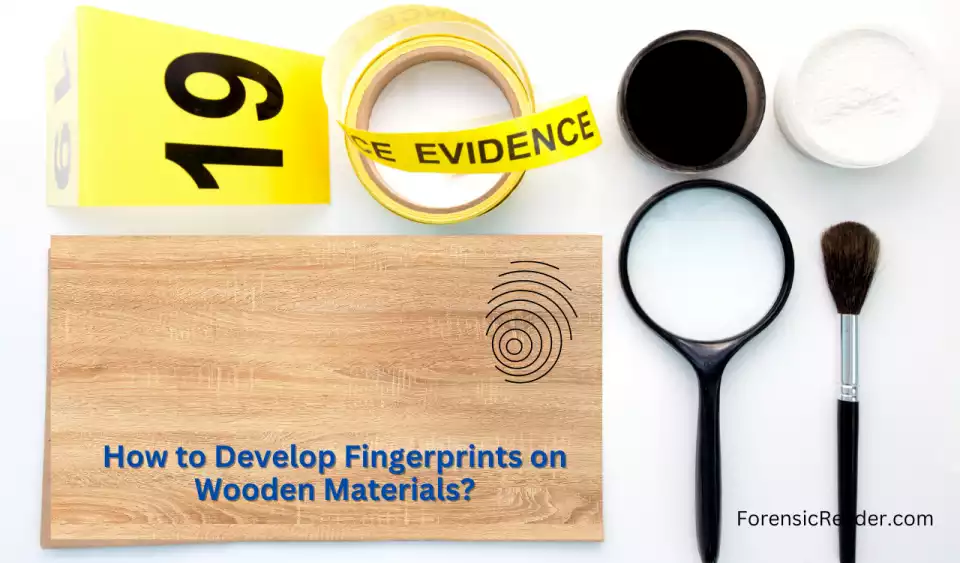Finding fingerprints on wood can be challenging. However, with the correct developing technique, it is possible. Here are some interesting information regarding fingerprints on wood and how you can develop them.
[Table] How Long Fingerprints can be Found on Wooden Surfaces?
| Wooden Surface Type | Fingerprint Stays on Surface* |
|---|---|
| Tree bark | Rarely Seen |
| Raw wooden Logs without barks | 3-6 months |
| Unfinished and non-sanded | 3-6 months |
| Sand off wood | 6-9 months |
| Varnished/Lacquered Finished | 6 months |
| Wax finished | 6 months |
| Wood dye and stain | 3 months |
| French polish | 3-6 months |
| Hardwood flooring | 3-4 months |
| Vinyl flooring | 3-6 months |
| Oak Flooring | 3-6 months |
When Fingerprints can be found on Woods and When Not?
Following are the parameters that can determine whether you find a fingerprint or not on a wooden surface.
I. Varnished and Painted Surfaces
Varnished and painted surfaces of wood are non-porous and do not absorb the constituents of sweat from fingerprint residue. This makes a superficial layer of sweat that is prone to environmental effects and can be washed away easier than on raw wood that is porous in nature.
Research has proven that painted wood can show traces of fingerprints for up to 6 months. And many references state that raw wood will preserve the fingerprint for a longer time and it can be developed using techniques that detect the amino acid constituents in sweat.
II. Environemtal Conditions
There are various environmental conditions like sunlight, temperature, and humidity that can degrade the fingerprint.
A. Exposure to Sunlight
Exposure to sunlight increases the rate of degradation of the lipids present in the fingerprint sweat like unsaturated fatty acids and cholesterol. Photo oxidation takes place as age increases.
B. Temperature
Increased temperature degrades amino acids at a higher rate and also results in water loss from the fingerprint resulting in faster degradation.
B. Humidity
Humidity has some enhancing effects on the development of latent fingerprints as it affects the eccrine constituents. It does not show much influence on DFO development but has some effect on the cyanoacrylate fuming technique.
Humidity is also more prominent in cases of porous substrate compared to the non-porous substrate as the substrate absorbs the water content.
Read More: How fingerprints on human skin can be developed?
Common Developing Fingerprints Methods on Wood and Wooden Materials

| Wooden Surface | Development Technique |
|---|---|
| Raw wooden Logs without barks | Silver nitrate, Physical Developer |
| Unfinished and non-sanded | Iodine–benzoflavone, Silver nitrate |
| Sand off Wood, | Silver nitrate, Physical Developer |
| Varnished/Lacquered Finished | Cyanoacrylate (CA) fuming, Luminescent powder |
| Wax finished | Fingerprint powders |
| French polish | CA fuming, VMD |
| Hardwood flooring | CA fuming, VMD |
| Vinyl or Oak flooring | CA fuming, VMD |
Flynn and coworkers (2004) use iodine–benzoflavone solution for the development of fingerprints on treated and raw wood. They state that iodine–benzoflavone was the best technique for the development of prints on wallpapers, vinyl, bricks, and raw wood that are 3 to 4 days old.[Pubmed]
Developing Fingerprints on Polished Wood Vs Raw wood
| Raw Wood (Porous) | Treated Wood (Non-porous/Semi-porous) |
|---|---|
| Silver Nitrate (best method) | Cyanoacrylate fuming (best method) |
| Physical Developer | Vacuum metal deposition (VMD) |
| Iodine fuming/ Benzoflavone* | Iodine fuming/ Benzoflavone |
| DFO | Luminescent Powder |
Note: Developing fingerprints on wood using a staining solution should be avoided because the wooden surface itself strongly absorbs the stain which makes it difficult to detain with a destaining solution.
Is it Possible to extract DNA from Fingerprints on Wood? Why so?
Yes, DNA can be extracted from the fingerprint of wood, especially in cases of raw or unpolished wood that absorbs the constituents of sweat (unless the wood’s DNA doesn’t hinder identification).
Compared to other substrates like glass and plastic, wood has more absorbing power that yields more DNA from swabs. The likelihood of obtaining an identifiable profile of the person of interest from fingerprints on wood is 36% which is higher than other mentioned substrates.
However, in any case, the chance of getting DNA decreases as it ages.
Read More: Fingerprints on Plant Leaves: How to Find and Develop them?
References:
- Bunter, S., & Ffs, B. (2014). How Long Can an Identifiable Fingerprint Persist on an Exterior Surface? [ResearchPaper]
- Cadd, S., Islam, M., Manson, P., & Bleay, S. (2015). Fingerprint composition and aging: A literature review. Science & Justice. [ScienceDirect]
- Christophe Champod. (2016). Fingerprints and other ridge skin impressions. Crc Press, Taylor & Francis Group.
- Daly, D. J., Murphy, C., & McDermott, S. D. (2012). The transfer of touch DNA from hands to glass, fabric and wood. Forensic Science International: Genetics.[FSIGenetics]

FR Author Group at ForensicReader is a team of Forensic experts and scholars having B.Sc, M.Sc, or Doctorate( Ph.D.) degrees in Forensic Science. We published on topics on fingerprints, questioned documents, forensic medicine, toxicology, physical evidence, and related case studies. Know More.
